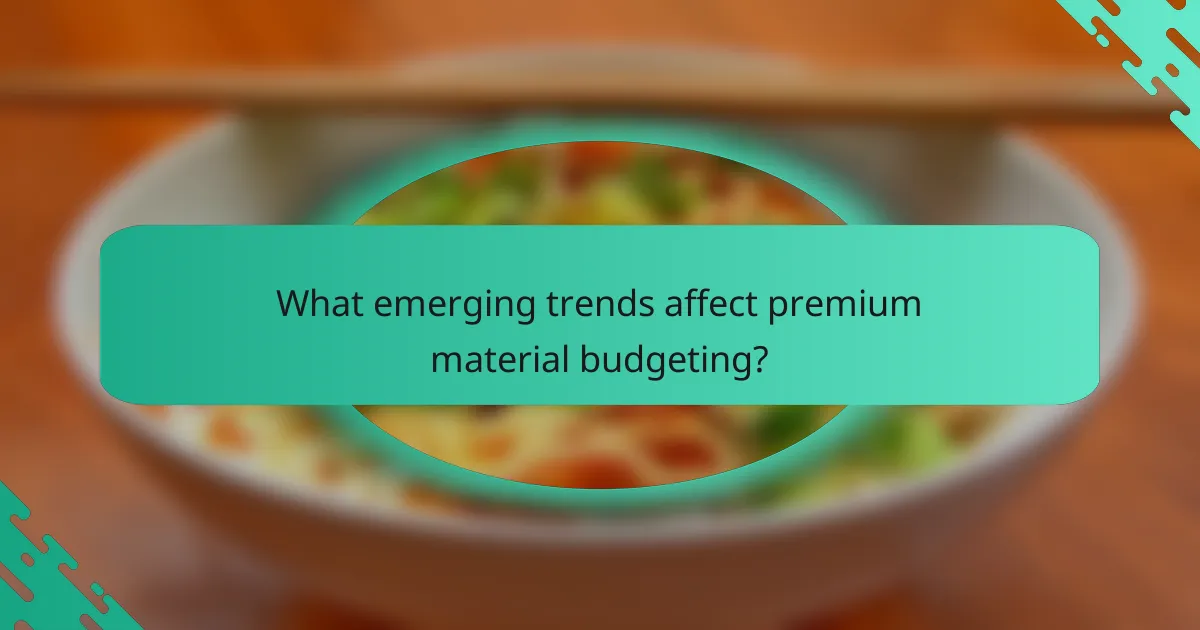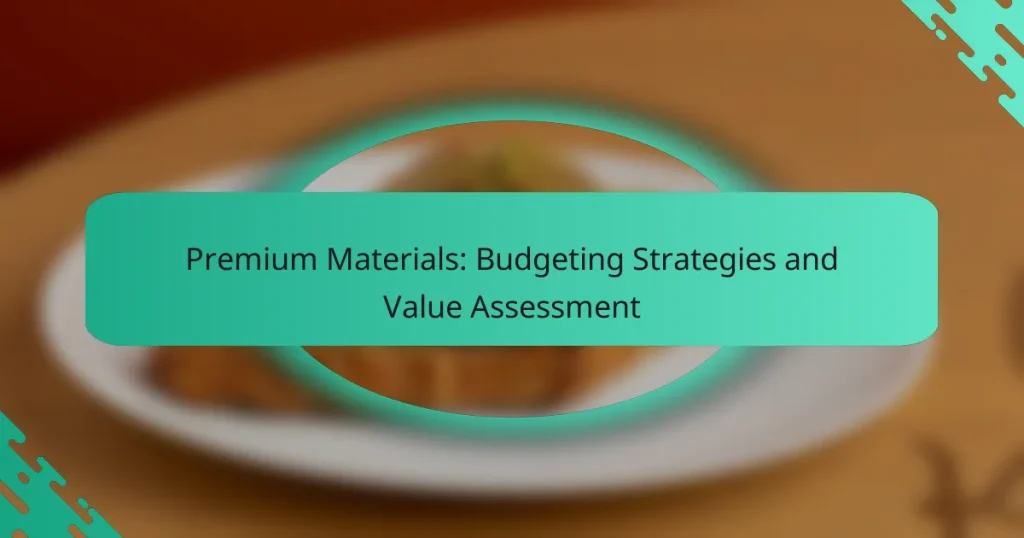When budgeting for premium materials, it’s essential to strike a balance between quality and cost-effectiveness. By carefully assessing the benefits and longevity of materials, prioritizing essential items, and utilizing local suppliers, you can maximize value while minimizing expenses. Avoid common pitfalls such as overlooking hidden costs and staying uninformed about market trends to ensure successful project outcomes.

What budgeting strategies maximize value for premium materials in Los Angeles?
To maximize value for premium materials in Los Angeles, focus on strategic budgeting that balances quality with cost-effectiveness. This involves assessing the benefits of materials against their costs, prioritizing essential items, and leveraging local suppliers to reduce expenses.
Cost-benefit analysis
A cost-benefit analysis helps determine whether the advantages of premium materials justify their higher price. Evaluate factors such as durability, maintenance costs, and aesthetic appeal against the initial investment. For example, while high-quality flooring may cost more upfront, it could save money in the long run due to its longevity and lower maintenance needs.
Consider creating a simple table to compare options, listing materials, costs, expected lifespan, and maintenance expenses. This visual aid can clarify which materials offer the best overall value.
Prioritizing essential materials
Identifying and prioritizing essential materials is crucial for effective budgeting. Focus on items that significantly impact the project’s functionality and appearance. For instance, investing in high-quality roofing or insulation can enhance energy efficiency and reduce long-term costs.
Rank materials based on their necessity and potential return on investment. This approach ensures that funds are allocated to the most impactful areas, avoiding overspending on less critical components.
Utilizing local suppliers
Working with local suppliers in Los Angeles can lead to significant savings on premium materials. Local vendors often have lower shipping costs and can provide quicker delivery times, reducing project delays. Additionally, they may offer insights into regional trends and preferences that can enhance your project’s appeal.
Establish relationships with multiple suppliers to compare prices and negotiate better deals. This competition can help you secure the best value for your premium materials.
Long-term investment considerations
When budgeting for premium materials, consider their long-term investment potential. High-quality materials may have a higher initial cost but can lead to savings over time through reduced maintenance and replacement needs. For example, energy-efficient windows can lower utility bills significantly over their lifespan.
Assess the expected lifespan and resale value of materials. Investing in premium options that enhance property value can yield substantial returns when selling or renting the property in the future.

How to assess the value of premium materials?
To assess the value of premium materials, consider their quality, durability, and brand reputation. Evaluating these factors helps determine whether the higher cost is justified compared to standard options.
Quality versus price comparison
When comparing quality and price, focus on the specific attributes that define premium materials, such as composition, craftsmanship, and performance. Higher-priced materials often offer superior characteristics, but it’s essential to identify which features are most relevant to your needs.
For example, a premium fabric may cost significantly more than a standard one, but if it offers better breathability and comfort, the investment might be worthwhile. Create a simple comparison chart to weigh the benefits against the costs for clarity.
Durability and lifespan evaluation
Durability is a critical factor in assessing premium materials, as it directly impacts their lifespan and overall value. Premium materials typically withstand wear and tear better than cheaper alternatives, which can lead to long-term savings.
For instance, a high-quality leather may last several years longer than synthetic options, reducing the need for replacements. Consider the expected lifespan of materials in relation to their cost to determine if they provide good value over time.
Brand reputation impact
Brand reputation plays a significant role in the perceived value of premium materials. Established brands often invest in quality control and customer satisfaction, which can translate into better products.
Research customer reviews and industry ratings to gauge the reliability of a brand. A well-regarded brand may justify a higher price due to its commitment to quality and service, making it a safer investment in the long run.

What are the common pitfalls in budgeting for premium materials?
Common pitfalls in budgeting for premium materials include miscalculating their longevity, overlooking hidden costs, and failing to stay updated on market trends. These mistakes can lead to overspending and inadequate resource allocation, ultimately affecting project outcomes.
Overestimating material longevity
One major pitfall is overestimating how long premium materials will last. While high-quality materials often have longer lifespans, factors like environmental conditions and usage can significantly impact durability. For instance, a premium wood may last decades indoors but deteriorate quickly outdoors.
To avoid this mistake, conduct thorough research on the specific materials you plan to use. Look for case studies or reviews that provide insights into real-world performance, and consider consulting with industry experts to get realistic longevity estimates.
Neglecting hidden costs
Hidden costs can quickly inflate the budget for premium materials. These may include shipping fees, installation expenses, and maintenance requirements that aren’t immediately apparent. For example, a high-end flooring material might seem affordable until you factor in the cost of specialized installation.
To mitigate this risk, create a comprehensive budget that includes all potential costs associated with premium materials. Break down expenses into categories, such as procurement, installation, and long-term maintenance, to ensure a clearer financial picture.
Ignoring market trends
Ignoring market trends can lead to purchasing decisions that are not financially sound. The prices of premium materials can fluctuate based on demand, availability, and new innovations. For example, a surge in demand for eco-friendly materials may drive up prices unexpectedly.
Stay informed about market trends by subscribing to industry publications, attending trade shows, or joining relevant online forums. Regularly reviewing market conditions can help you make timely purchasing decisions and potentially save money by buying materials when prices are lower.

What criteria should be used for selecting premium materials?
When selecting premium materials, consider factors such as durability, aesthetic appeal, and cost-effectiveness. These criteria help ensure that the materials not only meet performance expectations but also provide long-term value for your investment.
Material performance metrics
Material performance metrics include strength, longevity, and resistance to wear and tear. For instance, materials like high-grade steel or advanced composites often exhibit superior tensile strength and durability compared to standard options. Evaluating these metrics helps determine how well a material will perform under specific conditions.
Consider conducting tests or reviewing third-party certifications to assess these performance metrics. For example, materials that meet ISO or ASTM standards are typically reliable choices. Additionally, look for warranties that reflect the expected lifespan of the material, which can range from several years to decades.
Environmental impact assessments
Environmental impact assessments evaluate how materials affect ecosystems and human health throughout their lifecycle. This includes examining resource extraction, manufacturing processes, and end-of-life disposal. Selecting materials with lower environmental footprints can enhance sustainability and appeal to eco-conscious consumers.
To assess environmental impacts, consider certifications such as LEED or Cradle to Cradle, which indicate that materials meet specific sustainability criteria. Additionally, prioritize materials that are recyclable or biodegradable, as these options can significantly reduce waste and pollution. For example, bamboo and recycled metals are often seen as environmentally friendly choices.

How can local services assist in premium material budgeting?
Local services play a crucial role in premium material budgeting by offering tailored advice and expertise that align with regional market conditions. They can help assess costs, identify quality suppliers, and optimize resource allocation to ensure that budgets are effectively managed.
Consultation services
Consultation services provide valuable insights into selecting premium materials that fit your budget. Local experts can analyze your project requirements and recommend materials that offer the best balance of quality and cost-effectiveness. For instance, they might suggest alternatives that maintain aesthetic appeal while being more affordable.
When engaging with consultation services, consider asking for a detailed breakdown of material costs and potential savings. This can help you make informed decisions and avoid overspending. Additionally, ensure they are familiar with local suppliers to leverage any regional pricing advantages.
Project management support
Project management support is essential for keeping your premium material budgeting on track. Local project managers can oversee procurement processes, ensuring that materials are sourced efficiently and within budget constraints. They can also coordinate timelines to prevent delays that could lead to increased costs.
Utilizing project management tools can enhance transparency and communication among stakeholders. Regular budget reviews and updates can help identify any discrepancies early, allowing for timely adjustments. Be cautious of scope creep, which can inflate costs; clearly define project parameters from the outset to mitigate this risk.

What emerging trends affect premium material budgeting?
Emerging trends in premium material budgeting are influenced by sustainability, technological advancements, and shifting consumer preferences. These factors require businesses to adapt their budgeting strategies to ensure they remain competitive while maintaining quality.
Sustainability and Eco-Friendly Materials
Sustainability is increasingly becoming a priority for consumers, leading to a rise in demand for eco-friendly materials. Companies must consider the cost implications of sourcing sustainable options, which can sometimes be higher than traditional materials. However, investing in green materials can enhance brand reputation and appeal to environmentally conscious customers.
When budgeting for sustainable materials, businesses should evaluate the long-term savings associated with energy efficiency and reduced waste. For example, using recycled materials can lower production costs over time, even if the initial investment is higher.
Technological Innovations in Material Production
Technological advancements are transforming how premium materials are produced, often leading to cost reductions and improved quality. Innovations such as 3D printing and advanced manufacturing techniques can lower material waste and enhance design flexibility. Companies should explore these technologies to optimize their material budgets.
Incorporating technology into material sourcing can also streamline operations. For instance, utilizing software for supply chain management can help track material costs and availability, enabling better budgeting decisions.
Consumer Preferences and Market Trends
Shifting consumer preferences significantly impact premium material budgeting. As trends evolve, businesses must stay attuned to what customers value, such as durability, aesthetics, and ethical sourcing. Understanding these preferences can guide material selection and budgeting priorities.
To effectively budget for materials that align with consumer trends, companies should conduct market research and gather feedback. This approach can help identify which premium materials will resonate with target audiences, ensuring that investments yield a favorable return.


